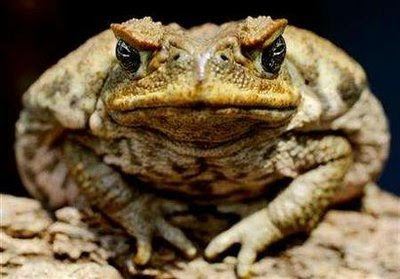The Cane Toad isn't even a native to Australia. Though it hails from Central America, it was introduced into Australia via Hawaii back in 1935 as a way to control the sugar cane beetle (ergo, the Cane Toad?). 3,000 individual toads were introduced. Estimates now place the toad's population in Australia at 200 million. Now, when viewed from a propagation-of-the-species perspective, that's one successful toad. This toad's stowaway behavior seems to be working for it, much to Australia's and East Timor's dismay. It really is a blight upon any ecosystem it enters.
This picture could be one of a Cane Toad, and artist's representation of Professor Umbridge, or a screenshot of Mike's nemesis from from Monsters, Inc. You decide.
Thanks for the article, Ida.
Photo source: Reuters


That is priceless. Absolutely wonderful...!
ReplyDeleteChristie
Australia and Hawaii both are beautiful examples of all the bad things that can happen when you introduce an animal that doesn't belong. Cats are killing endemic birds on the islands, and rabbits are killing all the vegetation Down Under.
ReplyDeleteHumans don't learn very well...
I agree with Wendy. The ecosystems are so fragile and once something like this happens, no one knows how to repair it. I am devastated I can't live in Hawaii because I'd never give up my iguana, but respecting the delicate system of the earth is more important.
ReplyDeleteAs for the toad, as destructive as he may be, is still cute. I vote for Mike's nemesis on Monsters Inc.
I'm not one to usually suggest something like this, but (a) it's an invasive species that shows no sign of slowing down, and (b) those look like some pretty hefty frog legs. I'm just saying.
ReplyDeletehttp://farm1.static.flickr.com/231/491937604_1a8e862cfd.jpg?v=0
ReplyDeleteI love driving over them after its been raining... *pop*
ReplyDeleteheh heh heh.
They are, after all, killing of our native wildlife and are just plain UGLY!!!
Why aren't all the non-native brown snakes in Hawaii (and elsewhere) noshing down these hoppers? Heck, they look like a pretty substantial meal... or are these critters too poisonous to have for dinner?
ReplyDeleteDisapproving Rabbits have nothing on this baby!
ReplyDeleteAlthough I understand and appreciate that cane toads are very destructive in Australia and on ecosystems they were never meant to inhabit, I have kept them as pets for over a year now and they are delightful creatures to watch. So cute, so ugly, so grumpy!
ReplyDeleteBy the way, when I was reading Harry Potter I always imagined Prof Umbridge looked like Jo Brand. Jo Brand looks like a toad.
I would like to know if there is any real scientific evidence that these toads are destructive? I dont know anything about it, and I understand its quite possible, however I know of a number of species which people believe are "destroying ecosystems" when in reality, there is no actual evidence. For example the luthrum salicaria in Ontario Canada. There was a lot of people trying to figure out how to get rid of it, a lot of money was spent on plans, and there was no real evidence it was causing a problem. There have recently been a few studies on this plant and so far it looks like it is a food source to a number of species, and there is no evidence to suggest it out competes any of the natural species. This is only one example and I recognize that this toad very well may be a problem, I would just like to know if there is any scientific evidence to support these claims? Just because a species didnt originate there, does not mean it is a problem.
ReplyDeleteIt's true that in some cases, all of the mitigation may not be worth it for invasive species. Some examples would be some aquatic plant nuisance species in wetlands. In some cases it's almost impossible to get rid of them, and while they do alter the habitat, they also have some benefits to the functioning of the ecosystem, and it may be a better idea to just prevent their spread and try to tame the populations, rather than aim for complete eradication.
ReplyDeleteI don't know the cane toad's story very well, but I imagine that it is a voracious predator that's suited to the new habitat it's in, reproduces really well, doesn't have much predation upon it (they're poisonous, right?)... and hence their able to spread and disrupt other ecosystems. If their population had stayed small, they wouldn't be much of a problem, but that's not the case.
I've heard other ladies enjoy popping them under tires as Tracy said. It must be the satisfying pop they make!??
ReplyDelete